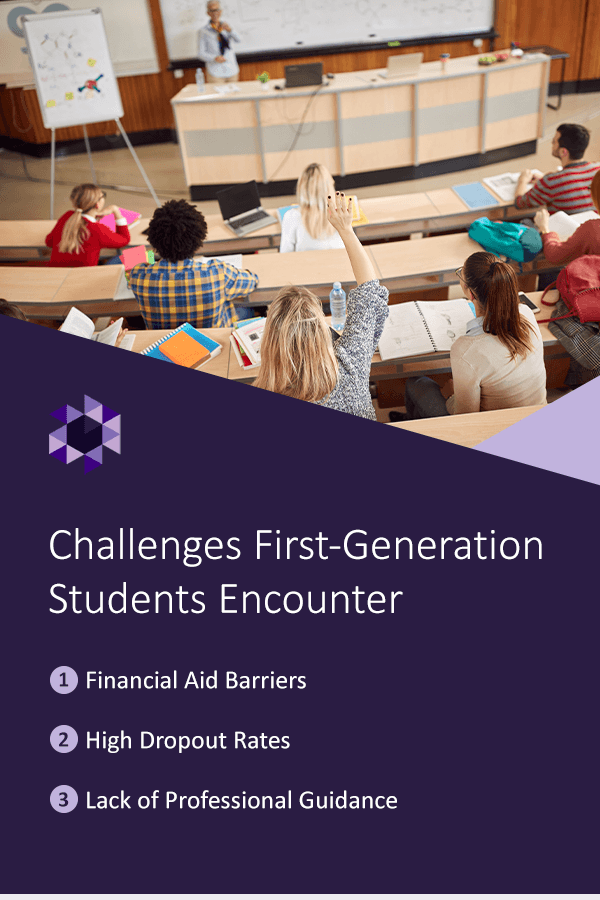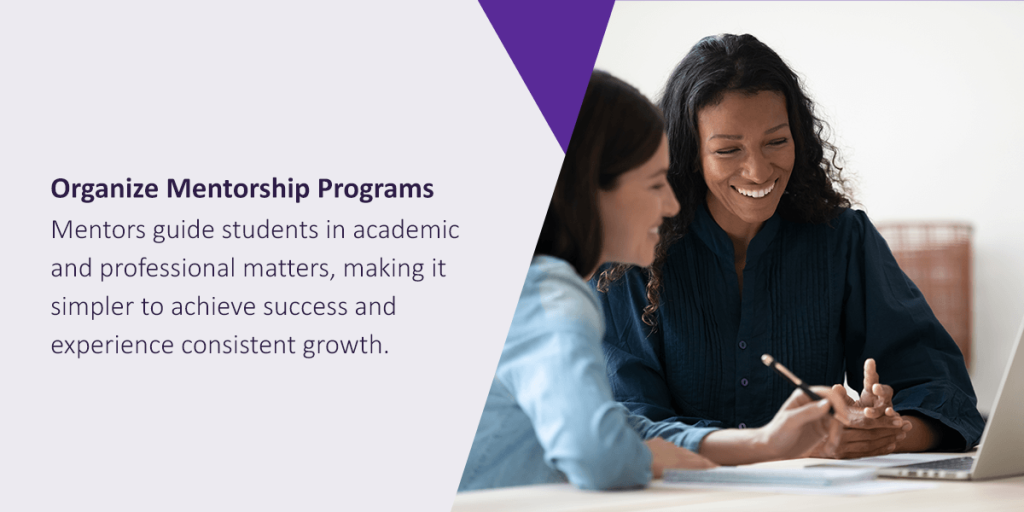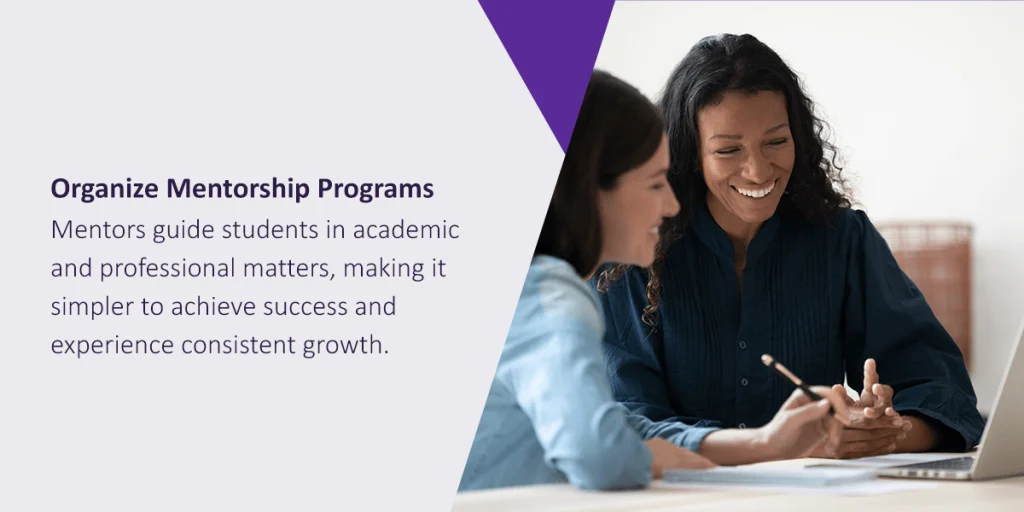Being a first-generation student in a higher education institution is a huge achievement that requires commendation. As institutions become more diverse and admit students from all walks of life, providing the necessary support to help with the academic and professional success of all students becomes increasingly crucial. Considering that first-generation and low-income students may be disadvantaged in several ways, robust support is particularly important for these populations.
In this comprehensive guide, we discuss who first-generation students are in detail, the common challenges they face, and the best practices higher ed institutions can use to support students within this category.
What Does It Mean To Be a First-Generation Student?
Higher education institutions may have different definitions for “first-generation students.” For example, a first-generation student at Brown University is one who may self-identify as lacking prior exposure to or knowledge of navigating a higher ed institution. Northwestern University defines a first-generation college student as the first to graduate from a four-year college or university in a family. University at Buffalo also qualifies students whose parents or legal guardians have not achieved a bachelor’s degree at the time of their first application to the university or for financial aid in the institution as first-generation students.
The Center for First-Generation Student Success acknowledges the definitional diversity and emphasizes that defining the term is crucial to help higher education institutions. They encourage institutions to:
- Identify first-generation students.
- Pinpoint their needs for early intervention.
- Track their academic and extracurricular progress.
- Highlight successes.
- Measure critical learning outcomes.
- Benchmark against other institutions and national datasets.
It’s also essential to clarify that first-generation and low-income students are distinguishable, although they are often discussed together. Institutions may define low-income students as those who qualify for Pell Grants — a federal grant offered to families with income below $50,000. This means that students from middle- or high-income families may fall outside this category, although they may qualify as first-generation students.
The two concepts are often discussed simultaneously because college graduates without college-educated parents generally have lower incomes and less wealth. In any case, the true essence of finding a common denominator is to identify individuals with shared challenges and provide the needed support to help them overcome hurdles they may face during their educational journey.
Challenges First-Generation Students Encounter
First-generation, low-income students encounter several challenges, some of which include the following:

1. Financial Aid Barriers
The National Center for Education Statistics (NCES) has revealed that first-generation and low-income students are less likely to complete a Free Application for Federal Student Aid (FAFSA), causing them to miss out on financial aid opportunities that could help them pay for and pursue higher education even when they qualify.
Additionally, most financial aid official letters are mired in inconsistent terminologies and jargon and lack some relevant information. This makes it difficult to understand and compare aid offers when deciding which institutions best suit their financial needs. Students may end up joining a school with inadequate and inaccurate financial information.
2. High Dropout Rates
First-generation students may leave postsecondary education without earning the necessary credentials. Low-income students are also more likely to leave a two- or four-year institution before receiving a degree. This creates further financial implications since students may be required to repay loans even when they don’t reap the benefits.
3. Lack of Professional Guidance
First-generation students lack mentors and networks to assist with professional development, meaning they must build from scratch. This may add pressure on students who struggle to manage academic demands.
How to Support First-Generation Students
Here is a comprehensive guideline about supporting first-generation college students:

1. Clearly Define What “First-Generation” Means
As discussed, higher education institutions may have different definitions for first-generation students, which affects the persons who fall within the category and the scope of support the institutions provide. While there is no unified description, defining the demographic with essential variables in mind is an excellent approach. For example, you may adopt a broad definition that includes students whose:
- Parents started higher education but were unable to graduate.
- Parents or close relatives attended higher education outside the country.
- Parents or close relatives never attended a higher education institution.
- Siblings attended a higher education institution, but their parents did not have the same opportunity.
2. Reach Out Early
Identify your first-gen and low-income students early and initiate conversations about life in higher education institutions and coursework. This eases the transition and helps with a good start.
To reach students early, you can organize a special orientation or events. Orientation is an excellent opportunity to introduce first-generation students to college or university life, helping them understand how to overcome unique challenges with confidence. Orientation may consist of the following:
- Helpful resources: Use orientation to inform students about special resources and where they can go for help when they need it. Since orientation often covers a significant amount of information, consider handing out packets students can refer to after the event ends.
- Introduction to campus life: Let first-generation students know how to get involved on campus through clubs, organizations, job opportunities, and volunteer placements. You can also let students know about all of the facilities they can use and provide a tour of the campus.
- Opportunities to meet faculty: Give first-generation students opportunities to meet the faculty members who can help them on campus.
- Opportunities to connect with other students: Forming friendships and building a community on campus can help first-generation students tremendously. Consider hosting some ice-breaker activities during orientation to help students meet fellow first-year students.
3. Expand the Scope of Your Counsel
First-gen students may inadequately assess their strengths and weaknesses in higher education and have little exposure to the processes and requirements in higher education institutions. Cover the basic demands of higher education, career, and the need for self-assessments, and help them appreciate how essential it is to connect their abilities and interests. You can do this by conducting early aptitude assessments and helping them identify areas of focus.
Aptitude tests can help students make important academic and career decisions. With helpful insights into their greatest skills, strengths, and abilities, students can choose the majors and career paths that are right for them. A student may apply for college planning to take a specific career path but find that they are more motivated and successful in another area of study. Individuals are more likely to complete their degree program when they feel confident in their field of study, and aptitude tests can help students identify the best path early.
4. Involve the Family
The challenges first-generation students face are due to their parent’s inability to attend and share experiences in higher education institutions. Engaging families provides opportunities that orient first-gen parents to higher ed. This can help them support their children throughout their educational and professional journey.
5. Organize Mentorship Programs

Mentors guide students in academic and professional matters, making it simpler to achieve success and experience consistent growth. For first-generation students who lack such opportunities, organizing mentorship programs and assigning mentors to each student is a good start. This approach is especially helpful when the mentors can build trust with the students, allowing them to share their experiences and ask questions freely.
Alumni and faculty members, perhaps those who faced similar challenges, may be best-suited to play the role of mentors. They may understand the students’ concerns and needs better, making them more able to provide tailored advice. Mentors also introduce students to essential resources and assist them in making strong decisions.
6. Conduct Informational Workshops
Informational workshops bridge the gap in knowledge and help students navigate through higher education. It also builds strong character and helps students deal with challenges decisively.
For example, a workshop about imposter syndrome can assist students in battling doubts about intellectual abilities and fears of failure. Structural challenges may impact their academic progress, causing them to question their ability to succeed in a merit-based culture. Openly discuss imposter syndrome, and help students understand that such situations are typical.
- Informational workshops may also cover areas such as:
- Alumni networking
- Financial management
- Unwritten workplace protocols and rules
- Networking
- Research and academic writing
- Technical workshops such as data analysis and programming
- Soft skills such as teamwork, leadership, and communication
- Resume building
- Interview skills
- Entrepreneurship
- Community service
7. Ensure Financial Aid Transparency
Before anything, make first-generation students aware of all financial aid opportunities and provide any relevant information, including the cost of college, financial aid estimates, FAFSA completion tips, the types of financial assistance available, how to find and apply for scholarships and grants, and the best methods for securing loans.
Next, make it easier for students to interpret the offers they receive. It helps to follow standardized terminologies and templates to help students compare different offer letters. Finally, ensure that financial aid covers all or a significant portion of the student’s needs, including living expenses. You can enhance your financial aid transparency and support through:
- Training: The Office of the U.S. Department of Education provides a Financial Aid Toolkit for counselors to help students and families prepare for post-secondary education. Counselors can also attend conferences and complete training to increase their knowledge of financial resources.
- Outreach: You can also conduct outreach efforts to maintain financial aid transparency. Hosting campus events and presentations is a great way to inform students about their financial aid options and the steps they need to take.
- One-on-one counseling: Encourage each student and their family to meet with a financial aid counselor one-on-one to review offer letters, ask questions, and receive advice.
- Utilize social media: Consider posting information about financial aid on your college or university’s social media pages. Posts can provide students with financial aid tips or spread the word about upcoming financial aid workshops and presentations.
8. Ensure Academic Transparency
Due to the knowledge gap, first-generation students face “hidden curriculum” challenges — unspoken, unwritten, unofficial values, lessons, and perspectives. Hidden curricula obscure academic demands because they lean on past customs and practices, privileging continuing-generation students with prior knowledge or support systems that enable them to decipher such information. Therefore, it’s recommended that instructors:
- Connect students to resources outside the classroom.
- Explain standard practices, such as syllabi, in-class discussions, and office hours.
- Analyze assignments for transparency, such as providing a rationale for assignments and explaining expectations and grading rubrics.
- Commit to increasing classroom equity through constant reflection.
Educate faculty about the challenges first-generation students may face. Ensure professors understand how to support pupils so they can help them overcome potential barriers and achieve greater success in the classroom.
9. Improve Accessibility and Increase Awareness
Make first-gen students aware of academic and administrative services and help them navigate. For example, you can introduce students to campus resources during orientation, provide a list on the institution’s website, and issue regular emails to remind students of these opportunities. The resources may include tutoring, alumni networks, career centers, and financial aid offices.
10. Learn About Students’ Backgrounds
Due to the generational gap, higher education institutions may better understand legacy students than their first-generation counterparts. Understanding the students’ needs help you develop well-tailored programs to provide the required support. The more you know, the better.
11. Get To Know the First-Gen Community on Campus
First-gen and low-income students exist on almost every campus, but their identities may not be visible or apparent. This makes it challenging to know when and how to differentiate support. Engage students and conduct surveys to identify persons within this category. Be proactive in engaging older students, especially when there has been little or no previous or regular contact.
Also, understand that first-generation students have different experiences depending on their race, ethnicity, gender, immigration status, sexuality, or generational status, so it helps to listen carefully and observe closely to embrace cultural differences.
12. Share Experiences
First-gen students may lack relatable higher ed experiences, so it helps to share what they can expect. Guide them in the registration and course selection processes, which can be challenging initially. The aim is to help them assimilate and settle into your institution’s culture faster.
13. Partner With Other Students and Organizations
Your institution will always benefit from assistance developing higher education awareness programs. Allow first-generation students to lead initiatives and partner with organizations depending on institutional and student needs. For example, you can develop relationships with outreach organizations and community access groups to provide academic support to young people and leverage their expertise and resources.
14. Make Policies Explicit
Clarify policies in a syllabus whenever possible. For instance, you may give students a syllabus to help them understand an upcoming course better. The common areas to consider are policies regarding grading, participation, group work, and late work.
15. Make Out-of-Class Activities Flexible
First-generation students maybe have work and family obligations that make it difficult for them to participate in events outside the classroom or take advantage of office hours. Organize virtual meetings to allow students to attend out-of-class activities and provide a list of assignments and deadlines early. This can help them plan proactively and utilize these opportunities.
16. Provide Institution Search and Selection Assistance
The assistance you offer should go beyond current first-generation students. Provide higher ed candidates with knowledge about different types of institutions, selection processes, funding opportunities, and the various available courses. Higher ed institutions are better equipped to provide such information. Invest in outreach to get students involved in your school and comfortable exploring all the resources you offer.

17. Offer Assistance With Applications
In addition to assisting first-gen students with their search for the best-fit institutions, educate them about application processes and deadlines. For example, organize physical or virtual programs or upload instructional content on your website to guide candidates through applications. These materials may stress the importance of making copies of all parts of an application, reviewing forms before sending, and using their full names consistently.
18. Foster a Sense of Belonging
First-generation students may struggle more to form open, trusting relationships with others than their continuing-generation peers. A sense of belonging improves the individual’s mental health, academic performance, and social engagement. It is also vital for your institution’s progress. Create cohorts and networks, and strengthen community-based activities to foster a sense of belonging. Demonstrate empathy and adjust policies to make students feel welcome.
19. Appreciate How Financial Challenges Impact Learning and Engagement
Financial obligations and pressure impact students’ experiences. Some work part-time to help themselves afford the necessities to survive and achieve academic success. Others travel far from home without adequate financial support to chase their dreams. Research shows that the median parental income for first-generation students is $41,000, with that of continuing-generation students at $90,000. With the average cost of college at $35,551, these students need support.
20. Advocate on Behalf of Students
Supporting first-gen and low-income students requires systemic and institutional changes to remove all structural barriers that impede accessibility and success in higher education institutions. Advocate on behalf of the students and encourage them to contribute during student affairs forums.
21. Support Student Projects
Learning has become more engaging the ever, blending research with real-world projects. This drives students to identify their passion, purpose, and career path and helps them build the skills they need for the future. Help first-gen students deliver high-impact projects by creating hubs and support services.
22. Leverage Technology
Technology plays a significant role in supporting first-generation college students. Besides augmenting learning and encouraging social connections, technology streamlines administrative processes such as class registration, accessing course content, submitting assignments, performing evaluations, completing creative projects, paying bills, researching, and gathering data.
To plan your support initiatives, use targeted analysis of student enrollment, staff evaluations, student assessments, and financial aid models. For example, evaluating financial aid data allows you to identify any disconnect between students’ need and their ability to pay. It also helps you follow trends and compile a compelling academic portfolio to help students. This improves operational efficiency and quality and saves time and money. The more you understand your student needs, the better you can target your support efforts.

Watermark: The Premium Digital Tool for Campus Processes
Any approach to developing first-gen and low-income student support programs begins with understanding these students’ needs. Leveraging digital tools that collect, store, access, and analyze large datasets helps you achieve accurate results while saving time and money.
Watermark is an advanced higher ed technology that provides a centralized means of using data to drive institutional development efforts. Our 20-plus years of experience and knowledge in the space help us develop and install personalized solutions to your demands. Request a demo today and experience our solutions in action!












































































































































































































































































































































































































